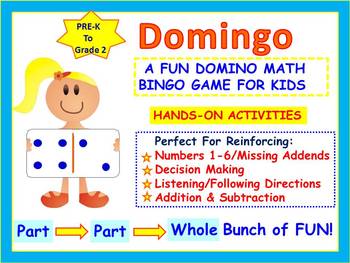Composing and Decomposing Numbers Using Dominoes is Hands-On Fun
Little Geniuses
163 Followers
Grade Levels
PreK - 2nd, Homeschool
Subjects
Resource Type
Standards
CCSSK.CC.A.1
CCSSK.CC.A.2
CCSSK.CC.A.3
CCSSK.CC.B.4a
CCSSK.CC.B.4b
Formats Included
- PDF
Pages
33 pages
Little Geniuses
163 Followers
Description
Domingo is an engaging, "hands-on" adding and subtracting game that motivates young learners to practice Missing Addend and other math skills in a very unique way.
With easy to follow instructions and excellent teaching tips, your students will be eager to "play math" using these exciting learning tools.
Students are keen to listen to the numbers being rolled and called out, before searching for a domino that will fit/work on their board. Students can add or subtract to solve each problem and they embrace the friendly competition, as they attempt to fill their board with winning dominoes, before their opponents.
Throughout the playing of the game, your students will reinforce their understanding of part/part/whole, how to use a number line to solve each problem, finding the missing addend and finally, how to record their math.
You can be the "Roller" and call out the numbers for your students and play as a whole class activity or have your students take turns being the "Roller" and Game Leader.
Domingo is also a MUST HAVE game for every math center, as the variety of game boards allow for many game sessions with different results.
The black-line master copies make this a wonderful game to send home for additional practice and parents appreciate that it is an inclusive activity for the whole family to enjoy.
Your "little geniuses" will really benefit from this motivating, exciting game as they learn their sums to 6.
With easy to follow instructions and excellent teaching tips, your students will be eager to "play math" using these exciting learning tools.
Students are keen to listen to the numbers being rolled and called out, before searching for a domino that will fit/work on their board. Students can add or subtract to solve each problem and they embrace the friendly competition, as they attempt to fill their board with winning dominoes, before their opponents.
Throughout the playing of the game, your students will reinforce their understanding of part/part/whole, how to use a number line to solve each problem, finding the missing addend and finally, how to record their math.
You can be the "Roller" and call out the numbers for your students and play as a whole class activity or have your students take turns being the "Roller" and Game Leader.
Domingo is also a MUST HAVE game for every math center, as the variety of game boards allow for many game sessions with different results.
The black-line master copies make this a wonderful game to send home for additional practice and parents appreciate that it is an inclusive activity for the whole family to enjoy.
Your "little geniuses" will really benefit from this motivating, exciting game as they learn their sums to 6.
Total Pages
33 pages
Answer Key
N/A
Teaching Duration
N/A
Last updated Nov 2nd, 2013
Report this resource to TPT
Reported resources will be reviewed by our team. Report this resource to let us know if this resource violates TPT’s content guidelines.
Standards
to see state-specific standards (only available in the US).
CCSSK.CC.A.1
Count to 100 by ones and by tens.
CCSSK.CC.A.2
Count forward beginning from a given number within the known sequence (instead of having to begin at 1).
CCSSK.CC.A.3
Write numbers from 0 to 20. Represent a number of objects with a written numeral 0-20 (with 0 representing a count of no objects).
CCSSK.CC.B.4a
When counting objects, say the number names in the standard order, pairing each object with one and only one number name and each number name with one and only one object.
CCSSK.CC.B.4b
Understand that the last number name said tells the number of objects counted. The number of objects is the same regardless of their arrangement or the order in which they were counted.





